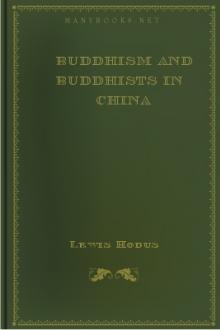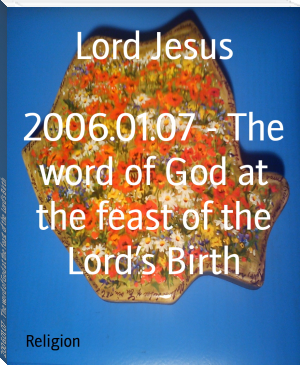The Bodhisatta in Theravada Buddhism, Nico Moonen [christmas read aloud .txt] 📗

- Author: Nico Moonen
Book online «The Bodhisatta in Theravada Buddhism, Nico Moonen [christmas read aloud .txt] 📗». Author Nico Moonen
Practise, development and, finally, perfection of the ten virtues lead to the attainment of perfect Enlightenment. These virtues are called the pāramīs, perfections. The Bodhisatta has to practice all of them to the highest degree of perfection. Sometimes he is aware that he is striving after Buddhahood, sometimes he is not.
During his last existence the Bodhisatta lives as a human male. In several stories it is claimed that in other existences he had lived as an animal. It seems reasonable to question how a Bodhisatta may be reborn in a lower world of existence. He performs only good activities, or at least he should. So rebirth as a human being or in one of the heavens should be the result. Does any animal have the necessary qualities to be able to practise any of the pāramīs? Is an animal able to have compassion for other animals or for human beings? Will it be possible to try to follow the perfections if one lives in the animal world? It appears to be doubtful.
All things are impermanent and subject to change. This characteristic of existence is the “creator” of time and therefore time is endless. In this endless circle of time there have been, according to Theravāda tradition, innumerable persons in the past who fulfilled the perfections and attained Buddhahood. And in the future too there will be innumerable Buddhas. A living Buddha predicts that all of those striving to fulfil the perfections will become a Perfectly Enlightened One, sammā sambuddha. So, at the moment there live many Bodhisattas somewhere in the worlds of existence.
According to Theravāda only one person receives from a living Buddha the prediction that he is a Bodhisatta, a future Buddha. Others may get a confirmation of a prediction that was made by a previous Buddha. According to Mahāyāna the path to Buddhahood may be followed by many simultaneously.
From much of the above examination of various texts it is clear that a number of erroneous beliefs and fanciful stories have emerged about Bodhisattas over the centuries. Therefore one must be careful and what is not credible must be separated from what is credible and in conformity with the teachings in the Pāli Canon. Therefore only very few things are reliable concerning the Bodhisatta in Theravāda.
Laypeople are, perhaps, best advised to take as their example a good lay follower rather than a monk (bhikkhu) or nun (bhikkhunī). For the way of laypeople is quite different from that of members of the Sangha.[367] The best layman we know is the Bodhisatta. And even if one does not follow the way to Buddhahood but the path to Arahantship, yet the Bodhisatta can be an example for all of us. The pāramīs can be followed as guide by everybody for they need not be fulfilled to the highest degree. The layman might take the Bodhisatta as an example by thinking:
May I be generous and helpful.
May I be pure, virtuous and well disciplined.
May I not be selfish and greedy, but unselfish and non-greedy.
May I be wise and may I be able to give the benefit of my knowledge and wisdom to others.
May I be diligent, energetic and persevering.
May I be patient and tolerant; may I be able to endure the wrongs of others.
May I be honest and truthful.
May I be steadfast, resolute and determined.
May I be kind and compassionate.
May I be humble, calm, imperturbable and peaceful.
In this way the path of the Bodhisatta can be followed by any layman or lay woman. And in this respect Mahāyāna and Theravāda do not differ very much from each other.
■ ■ ■
Bibliography
Bareau, André: ‘Der indische Buddhismus,’ in: Die Religionen Indiens, III, Stuttgart 1964, p. 1-215.
Bary, Wm. Theodore de (Gen.Ed.): Sources of Indian Tradition. Vol. I, comp. by A.L. Basham, R.N. Dandekar, Peter Hardy, V. Raghavan, Royal Weiler. New York: Columbia University Press, 1958. (Records of Civilizations).
Bischoff, Roger: Buddhism in Myanmar. A Short History. Kandy: BPS, 1995. The Wheel No. 399/401.
Bodhesako, Samanera: Beginnings. The Pali Suttas. Kandy: BPS, 1984. The Wheel No. 313/315.
Bodhi, Bhikkhu (tr.): The Discourse on the All-Embracing Net of Views : The Brahmajāla Sutta and its Commentaries. Kandy: BPS, 1978.
Bodhi, Bhikkhu (tr.): ‘A Treatise on the Pāramīs,’ in: The Discourse on the All-Embracing Net of Views : The Brahmajāla Sutta and its Commentaries. Kandy 1978, p. 254-330.
Buddharakkhita, Acharya: Nature of Buddha's Enlightenment. Bangalore: Buddha Vacana Trust, 1986. (Buddhayoga Meditation Series, 12).
Buddhaghosa, Bhadantācariya: The Path of Purification (Visuddhimagga). Transl. by Bhikkhu Ñānamoli. Singapore: Singapore Buddhist Meditation Centre, [1956].
Burlingame, Eugene Watson (tr.): 'Life of the Buddha,' in: Buddhist Legends, London 1979, Book 1, Story 8a (Vol. 28, p. 193-198).
Burnouf, M.E. (tr.): Le lotus de la bonne loi. Paris: Maisonneuve, 1973.
Conze, Edward (select. & tr.): Buddhist Scriptures. (repr.). Middlesex: Penguin Books, 1977. (1st ed. 1959).
Conze, Edward: A Short History of Buddhism. (repr). London: Unwin Paperbacks, 1986. (Mandala Books). (1st ed. 1980).
Dahlke, Paul (Übers.): Buddha. Auswahl aus dem Palikanon. Wiesbaden: Fourier, [s.a.]
De Silva, Lynn: Buddhism. Beliefs and Practices in Sri Lanka. (2nd rev. enlarged ed.). Colombo: Ecumenical Institute, 1980. (1st ed. 1974).
Dhammavuddho, Bhikkhu Hye: Main differences between Mahayana and Theravada Teachings. Penang, [s.a.].
Donath, Dorothy C.: Buddhism for the West - Theravāda, Mahāyāna and Vajrayāna: A Comprehensive Review of Buddhist History, Philosophy, and Teachings from the time of the Buddha to the present day. New York: The Julian Press, 1971.
Dutoit, Julius (übers.): Das Leben des Buddha. Eine Zusammenstellung alter Berichte aus den kanonischen Schriften der südlichen Buddhisten. Leipzich: Lotus-Verlag, 1906.
Dutoit, Julius (übers.): Jātakam. Das Buch der Erzählungen aus früheren Existenzen Buddhas. Leipzich: Lotus-Verlag, 1908. (7 Bände).
Ehrhard, Franz-Karl & Fischer-Schreiber, Ingrid (Verfasser u. Herausg.): Das Lexikon des Buddhismus. Redaktion: Stephan Schuhmacher und Gert Woerner. München (etc): Barth, 1992.
Finegan, Jack: The Archeology of World Religions : The Background of Primitivism, Zoroastrianism, Hinduism, Jainism, Buddhism, Confucianism, Taoism, Shinto, Islam, and Sikkhism. (4th printing). Princeton: Princeton University Press, 1971.
Geiger,W. (transl.): The Mahāvamsa or the Great Chronicle of Ceylon. Transl. by Wilhelm Geiger; assisted by Mabel Haynes Bode; with an Addendum by G.C. Mendis. (repr.). London: PTS, 1980. (1st ed. 1912).
Glasenapp, Helmuth von: Die Literaturen Indiens von ihren Anfängen bis zur Gegenwart. Wildpark-Potsdam: Athenaion, 1929. (Handbuch der Literaturwissenschaft).
Gnanarama, Ven. Pategama: The Mission Accomplished : A Historical Analysis of the Mahaparinibbana Sutta of the Digha Nikaya of the Pali Canon. Singapore: Ti-Sarana Buddhist Association, 1997.
Goddard, Dwight (ed.): A Buddhist Bible. Introduction by Huston Smith. Boston : Beacon Press, 1970. (1st. ed. 1938).
Gokhale, Balkrishna Govind: New Light on Early Buddhism. Bombay: Popular Prakashan, 1994.
Gombrich, Richard F.: Theravāda Buddhism. A Social History from Ancient Benares to Modern Colombo. London (etc): Routledge & Kegan Paul, 1988. (The Library of Religious Beliefs and Practices).
Gombrich, Richard F.: How Buddhism Began : The Conditioned Genesis of the Early Teachings. London: The Athlone Press, 1996. (Jordan Lectures in Comparative Religion XVII).
Grönbold, Günter: 'Die Mythologie des indischen Buddhismus,' in: Wörterbuch der Mythologie, Bd. 5. Hrsg. H.W. Haussig, Stuttgart 1984, p. 285-508.
Grotefend, H. (entw.): Taschenbuch der Zeitrechnung des deutschen Mittelalters und der Neuzeit. Herausg. Th. Ulrich. (10. erw. Aufl.). Hannover: Hahnsche Buchhandlung, 1960. (1. Aufl. 1898).
Horner, I.B. (tr.): 'Discourse to Ganaka-Moggalāna (Majjhima Nikāya No. 107)', in: Taming the Mind. Discourses of the Buddha. Kandy: BPS, 1973 (second ed.). The Wheel Publication No. 51, p. 2-10.
Horner, I.B. (tr.): Chronicle of Buddhas (Buddhavamsa) and Basket of Conduct (Cariyāpitaka). London: PTS, 1975. (Sacred Books of the Buddhists, Vol. XXXI); (The Minor Anthologies of the Pali Canon, Part III).
Horner, I.B. (tr.): The Clarifier of the Sweet Meaning (Madhuratthavilāsinī) . Commentary on the Chronicle of Buddhas (Buddhavamsa) by Buddhadatta Thera. London: PTS, 1978. (Sacred Books of the Buddhists, Vol. XXXIII).
Horner, I.B. (tr.): Milinda's Questions. Vol. I & II. Oxford: PTS, 1990 & 1991. (Sacred Books of the Buddhists, Vol. XXII & Vol. XXIII). (1st ed. 1963 & 1964).
Horner, I.B. The Collection of the Middle Length Sayings (Majjhima-Nikāya), Vol. I. : The first fifty discourses (Mūlapaņņāsa). Transl. from the Pāli by I.B. Horner. Oxford: PTS, 2000. (Pali Text Society Translation Series, No. 29). First publ. 1954; repr. 2000.
Humphreys, Christmas: A Popular Dictionary of Buddhism. (2nd ed.). London: Curzon Press, 1976. (1st ed. 1962).
Ikeda, Daisaku: Buddhism, the First Millennium. Transl. by Burton Watson. Tokyo (etc): Kodansha International Ltd, 1977.
Jayawickrama, N.A. (ed. and tr.): The Chronicle of the Thupa and the Thupavamsa. London: PTS, 1971.
Jones, J.J. (tr.): The Mahāvastu. Volume I. London: PTS, 1987. (Sacred Books of the Buddhists Vol. XVI). (1st ed. 1949).
Kashyap, Bhikkhu J. (Gen. Ed.): The Apadāna (II) - Buddhavamsa - Cariyāpitaka (Khuddhakanikāya, Vol. VII). [s.l.]: Pāli Publication Board (Bīhar Government), 1959. (Nālandā-Devanāgarī-Pāli-Series).
Katz, Nathan: Buddhist Images of Human Perfection. The Arahant of the Sutta Pitaka Compared with the Bodhisattva and the Mahāsiddha. Delhi: Motilal Banarsidass, 1989. (1st ed. 1982).
Kern, H.: Geschiedenis van het Buddhisme in Indië. Haarlem: Tjeenk Willink, 1882. (2 dln.)
Khantipalo, Phra (comp.): The Splendour of Enlightenment : A Life of the Buddha. Bangkok: Mahāmakut Rājavidyālaya Press, 2530/1987, 2 Vols. (1st ed. 2519/1976).
King, Sallie B.: Buddha Nature. Albany: State University of New York Press, 1991. (SUNY Series in Buddhist Studies).
Kloppenborg, Ria: The Paccekabuddha. A Buddhist Ascetic. A study of the concept of the Paccekabuddha in Pali canonical and commentarial literature. Kandy: BPS, 1983. The Wheel No. 305/307.
Lamotte, Étienne: Histoire du Bouddhisme indien. Des origines à l'ère Shaka. Louvain-la-Neuve: Université de Louvain, 1976. (Publications de l'institut orientaliste de Louvain; 14).
Ledi Sayadaw, Mahāthera: Uttamapurisa Dīpanī. Manual of the Superior Man. Transl. by U Tin U. typescript, ca 1899. (only p. 1-50).
Ledi Sayadaw, Ven.: A Manual of the Excellent Man, Uttamapurisa Dīpanī. Transl. from the Burmese by U Tin Oo; edited by Bhikkhu Pesala. Kandy: BPS, 2000.
Ling, Trevor: A Dictionary of Buddhism. Indian and South-East Asian. Calcutta/New Delhi: Bagchi & Co, 1981. (Bagchi Indological Series, 2).
Malalasekera, G.P.: Dictionary of Pāli Proper Names. London: PTS, 1974. (Vol. I & II).
Ñānamoli Thera (tr.): The Buddha's Words on Kamma. Four Discourses of the Buddha from the Middle Length Collection. Edited by Khantipālo Bhikkhu. Kandy: BPS, 1977. The Wheel No. 248/249.
Narada Thera (tr.): The Dhammapada : Pali Text and Translation with Stories in brief and Notes. (3rd ed.). Colombo: BMS, 2522/1978 (1st ed. 1963).
Nārada Maha Thera: The Buddha and His Teachings. (4th enlarged ed.). Kandy: BPS, 2524/1980.
Nārada Maha Thera: ‘Pārami – Perfections,’ in: The Buddha and His Teachings. Kandy 1980, p. 576-611.
Neumann, Karl Eugen (Übers.): Die Reden Gotamo Buddhos. Aus der mittleren Sammlung Majjhimanikāyo des Pāli-Kanons. (4. Aufl.). Zürich: Artemis; Wien: Zsolnay, 1956. (Karl Eugen Neumanns Übertragungen aus dem Pāli-Kanon, Bd. I). (1. Aufl. 1896-1902).
Neumann, Karl Eugen (Übers.): Die Reden Gotamo Buddhos. Aus der längeren Sammlung Dīghanikāyo des Pāli-Kanons. (3. Aufl.). Zürich: Artemis; Wien: Zsolnay, 1957. (Karl Eugen Neumanns Übertragungen aus dem Pāli-Kanon, Bd. II). (1. Aufl. 1906-1912).
Norman, K.R.: Pāli Literature, including the Canonical Literature in Prakrit and Sanskrit of all the Hīnayāna Schools of Buddhism. Wiesbaden: Harrassowitz, 1983. (A History of Indian Literature, Vol. 7, Fasc. 2).
Norman, K.R. (transl.): The Group of Discourses (Sutta-Nipāta), Vol. I, transl. by K.R. Norman; with alternative translations by I.B. Horner and Walpola Rahula. London: PTS, 1984.
Nyānaponika (Übers.): Sutta-Nipāta : Früh-buddhistische Lehr-Dichtungen aus dem Pali-Kanon. Mit Auszügen aus den





Comments (0)